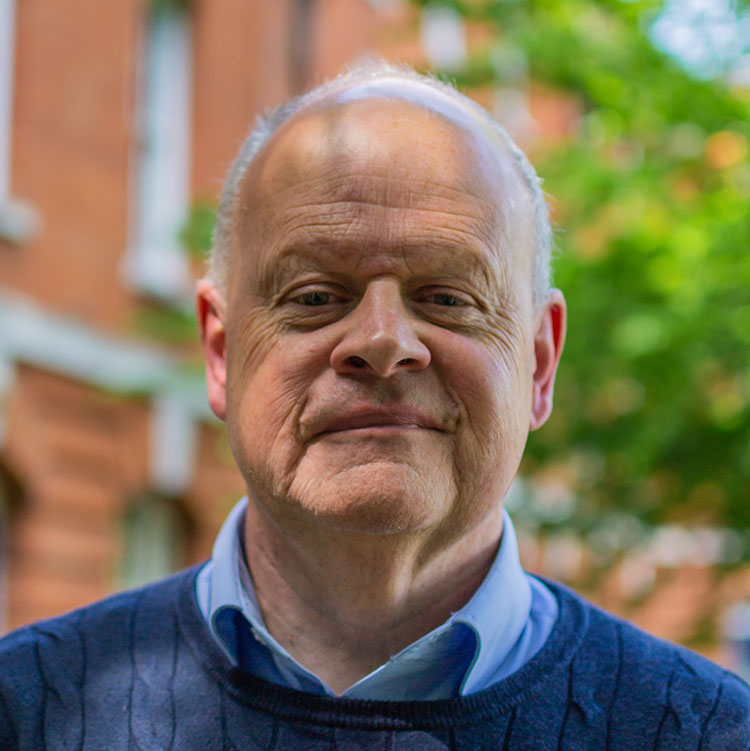
Professor Alistair Mathie
On this page
About
Alistair carried out his PhD research at the University of Leicester (1981-1984) supervised by Professor Asa Blakeley and Dr Stewart Petersen, and used intracellular electrophysiological recording techniques to study the electrical responses of sympathetically innervated smooth muscles, following neurotransmitter release at the neuroeffector junction.
Following his PhD, he spent five years as a postdoctoral research associate in the laboratories of Professors David Colquhoun and Stuart Cull-Candy at University College London (UCL) studying the biophysical properties of ligand- and voltage-gated ion channels in single, isolated mammalian neurons using patch-clamp and whole-cell electrophysiological recording techniques. Then, from 1989-1991 he held a Fogarty International Research Fellowship at the University of Washington in Seattle, based in the laboratory of Professor Bertil Hille where the major focus of his research was to apply his experience in electrophysiology to study the intracellular mechanisms activated by neurotransmitters which couple to G-proteins and how these can regulate the activity of voltage-gated ion channels.
In 1991, Alistair was appointed Lecturer in Pharmacology at the Royal Free Hospital School of Medicine then, following merger, a Senior Lecturer in Pharmacology at UCL. In 1999, he moved to Imperial College London where he took up a position there as Reader in Molecular Neuroscience. In 2007, he was appointed Professor of Pharmacology and Cell Biology, Head of Biological Sciences and Director of Research at the Medway School of Pharmacy.
Research interests
The primary research interests of myself and my colleagues can be described by the general term “bioelectricity”. This ranges from laboratory based experiments looking at the molecular and cellular properties of ion channel proteins that carry electrical signals across cell membranes to research aimed at improving approaches to measure electrical activity in patients (such as ECGs) in order to facilitate detection of conditions such as atrial fibrillation.
In our laboratory based research, we study the properties of ion channels, primarily potassium (K) channels, in mammalian neurons and smooth muscle cells and their modulation by various pharmacological agents, physiological mediators and neurotransmitter substances. Such ion channels are important in a variety of clinical conditions, such as epilepsy, stroke, neuropathic pain, pulmonary hypertension and depression and represent major potential therapeutic targets for current and future research. We use a variety of state-of-the-art methodologies to study the properties of these ion channels, including whole-cell and single-channel patch clamp electrophysiology, two-electrode voltage clamp from oocytes, molecular biology (such as site-directed mutagenesis), fluorescent imaging of intracellular ions and fluorescently labelled proteins, tissue culture and computer modelling of ion channel structure and functional behaviour. Much of our work is done in collaboration with other laboratories and, currently, we have collaborative ventures with the pharmaceutical industry, academic laboratories elsewhere in the UK, and groups in the USA, Germany, Spain, Austria and Australia. Our work has contributed greatly to the detailed understanding of the properties and regulation of K channels, exemplified by our many publications in high quality journals such as J Physiol, PNAS, J Neurosci, Brit J Pharmacol, Mol Pharmacol, Eur Resp J and J Biol Chem.
Current Research
Currently, we have a major project investigating the mutations in TASK-3 two pore domain potassium (K2P) channels, responsible for KCNK9 imprinting syndrome. Through clinical collaborators across the world, we are continually informed of new patients with mutations of KCNK9 (TASK-3). About half of these have the same “G236R” mutation as patients originally documented with this syndrome. However, there are now many other mutations identified in different regions of the TASK-3 channel. Two major complications have arisen from this. Firstly, the symptoms displayed by the patients vary quite widely both in their phenotype and in their intensity. Secondly, some of the mutations do not lead to the same functional alterations in the TASK-3 channel. As such, compounds which activate TASK-3 channels, a suggested therapy for the original patient cohort, may not be efficacious in all patients. At present, together with many colleagues around the world, we are trying to collate the information we have, both in terms of the patients and the properties of the mutated channels, to build as complete a picture as possible of this syndrome, its consequences and its potential treatment.
In addition, in the area of K2P channels, we have projects on the role and therapeutic importance of TASK-1 channels in pulmonary hypertension (with Dr Angel Cogolludo and colleagues in Madrid) and, more generally, on the role of infection in pulmonary hypertension as part of an international consortium led by my colleagues Professor Ghazwan Butrous and Professor Sir Magdi Yacoub. In a separate K2P channel project, we have just begun a formal, funded collaboration with Dr Paul Wright and colleagues at LifeArc Centre for Therapeutics Discovery to investigate novel K2P channel activators for the alleviation of pain. Away from K2P channels, we have started a collaboration with Dr Marc Fivaz (supported by a Leverhulme Trust Project Grant) to investigate the role of bioelectric signalling in human stem cell models of cortical development. We also have a couple of on-going projects on the properties and regulation of Kv channels, particularly inhibition by naturally occurring, highly potent toxins (in collaboration with Professor Murray Selkirk at Imperial College London).
Finally, moving away from direct ion channel research, but not bioelectricity, I am involved in a collaborative project led by my long–term collaborator, Dr Emma Veale, to look at the detection of atrial fibrillation (AF) by clinical pharmacists in primary care and the development of novel approaches to improve AF screening and detection, supported, primarily, by Bayer. This project was the recent recipient of a 2019 Healthcare Pioneers award from the Atrial Fibrillation Association.


